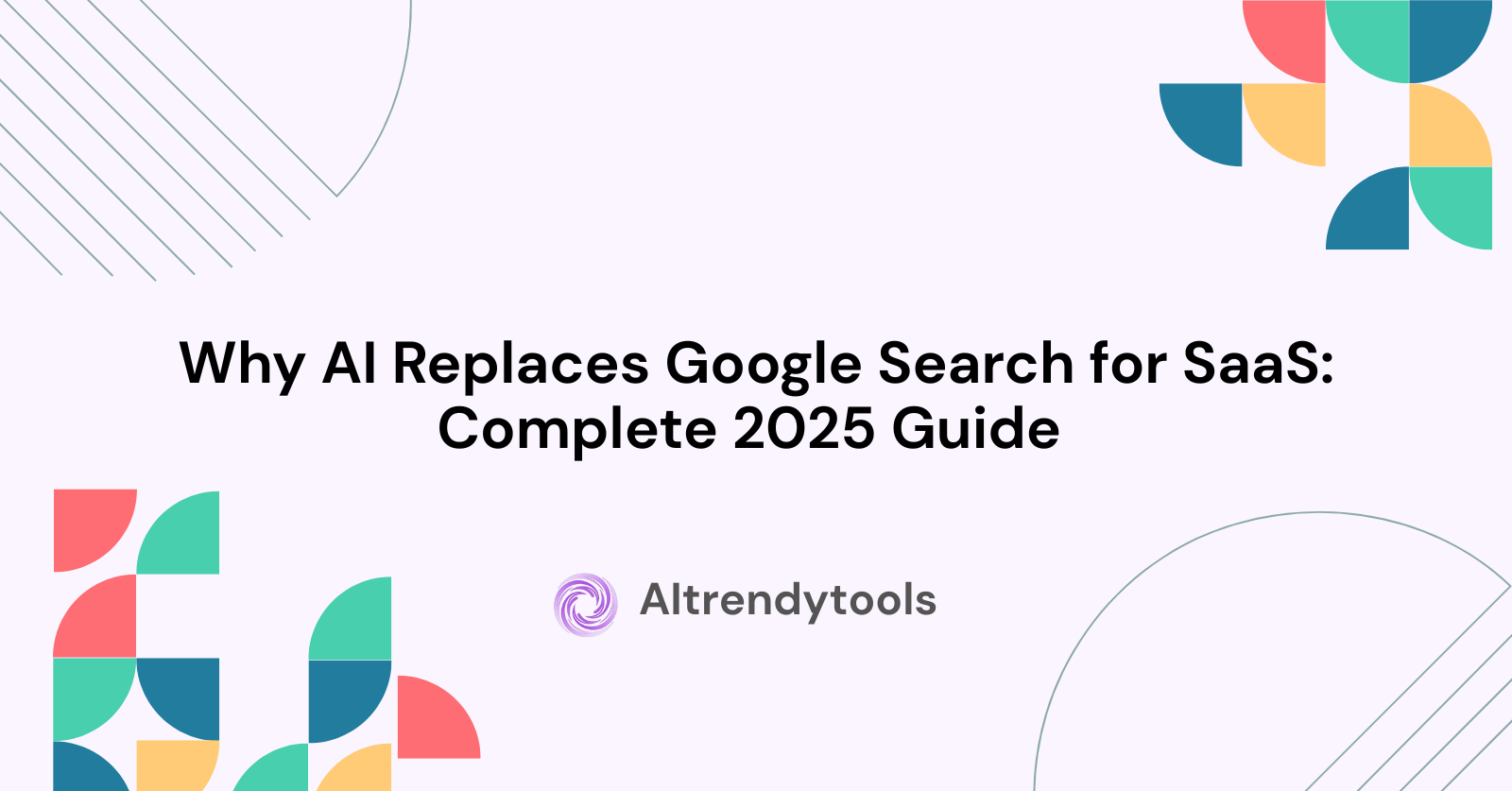🔥 AITrendytools: The Fastest-Growing AI Platform |
Write for usWhy AI Replaces Google Search for SaaS: Complete 2025 Guide
Discover how generative AI is transforming SaaS user research. Learn why ChatGPT, Claude & AI tools outperform Google for software discovery.
Sep 16, 2025
Generative AI vs Google Search Revolution
Generative AI is fundamentally changing how SaaS users discover, evaluate, and implement software solutions. Traditional Google search methods that once dominated the software research landscape are being replaced by intelligent AI assistants that provide personalized, contextual recommendations.
The shift represents more than just a change in search behavior. Generative AI platforms like ChatGPT, Claude, and specialized tools offer conversational interfaces that understand complex business requirements. Users can describe their specific needs in natural language and receive tailored software recommendations rather than sifting through pages of search results.
SaaS buyers increasingly prefer AI-powered research because it saves time and delivers more relevant results. Instead of spending hours researching different tools and reading countless reviews, users can engage in dynamic conversations that quickly narrow down options based on their exact requirements. This personalized approach addresses the information overload problem that traditional search engines often create.
The transformation affects every stage of the SaaS buying journey from initial discovery to final selection. Generative AI provides comprehensive comparisons, explains complex features in simple terms, and offers implementation guidance that traditional search results rarely deliver effectively.
SaaS User Search Behavior Changes
Modern SaaS users exhibit significantly different research patterns compared to previous generations of software buyers. The complexity of today's SaaS landscape has created demand for more sophisticated research tools that can process multiple variables simultaneously.
From Keywords to Conversations
Traditional Google searches required users to think in keywords and Boolean operators. Furthermore, SaaS buyers often struggled to translate their business needs into effective search terms. Complex software requirements don't easily map to simple keyword phrases, creating friction in the research process.
Generative AI eliminates this translation barrier by accepting natural language descriptions of business challenges. Users can explain their workflow problems, team size, budget constraints, and integration requirements in conversational terms. The AI then processes this context to suggest appropriate solutions without requiring technical search expertise.
Context-Aware Recommendations
Google search results provide information but lack the contextual understanding necessary for personalized recommendations. Meanwhile, generative AI platforms maintain conversation history and build understanding of user requirements throughout the research session.
This contextual awareness enables more refined recommendations as the conversation progresses. The AI can suggest alternatives when initial options don't meet specific criteria, explain why certain features matter for particular use cases, and identify potential implementation challenges before they become problems.
ChatGPT for SaaS Discovery Benefits
ChatGPT has emerged as a powerful tool for SaaS discovery, offering capabilities that traditional search engines cannot match. The platform's conversational interface and broad knowledge base make it particularly effective for software research.
Comprehensive Feature Comparisons
ChatGPT can analyze multiple SaaS tools simultaneously and provide detailed feature comparisons. Users receive side-by-side analyses that highlight key differences, pricing structures, and integration capabilities without visiting dozens of vendor websites.
The AI explains complex technical features in accessible language, making it easier for non-technical users to understand software capabilities. This democratization of technical knowledge helps smaller teams make informed decisions without requiring dedicated IT expertise.
Real-Time Questioning and Clarification
Unlike static search results, ChatGPT allows users to ask follow-up questions and request clarification on specific points. This interactive process helps users dig deeper into important considerations and explore edge cases that might affect their decision.
The ability to refine recommendations through continued conversation leads to more accurate final suggestions. Users can provide additional context about their specific requirements and receive adjusted recommendations that better match their actual needs.
AI-Powered SaaS Recommendations Accuracy
Generative AI platforms demonstrate superior accuracy in SaaS recommendations compared to traditional search methods. The combination of natural language processing and comprehensive knowledge bases enables more precise matching between user needs and software capabilities.
Personalized Matching Algorithms
AI recommendation systems consider multiple factors simultaneously when suggesting software solutions. Beyond basic feature matching, these systems evaluate:
- Company size and scalability requirements
- Industry-specific compliance needs
- Integration ecosystem compatibility
- Budget constraints and pricing models
- Implementation timeline considerations
- Team technical expertise levels
This multi-dimensional analysis produces recommendations that align more closely with actual user requirements. Traditional search engines rely primarily on keyword matching and SEO optimization, which may not reflect the best solutions for specific use cases.
Learning from User Feedback
Generative AI platforms improve their recommendations through continued interaction and feedback. As users provide more information about their requirements or express preferences for certain features, the AI adjusts its suggestions accordingly.
This learning capability creates a feedback loop that enhances recommendation quality over time. Users benefit from increasingly accurate suggestions as the AI better understands their specific context and preferences.
Google Search Limitations for SaaS
Traditional Google search faces several structural limitations when applied to SaaS research and discovery. These constraints have become more apparent as software options have proliferated and user requirements have become more complex.
SEO Gaming and Biased Results
Google search results are heavily influenced by SEO optimization rather than actual software quality or suitability. Companies with larger marketing budgets and sophisticated SEO strategies often dominate search results regardless of whether their solutions best meet user needs.
This creates a bias toward well-funded vendors while potentially overlooking smaller companies with superior products. SaaS buyers using traditional search methods may miss innovative solutions that lack extensive marketing resources but offer better value or functionality.
Information Fragmentation
Google search requires users to visit multiple websites, read various reviews, and synthesize information from disparate sources. This fragmented approach creates several problems:
- Inconsistent information across different sources
- Difficulty comparing features and pricing accurately
- Time-consuming research process
- Information overload from too many options
- Potential for outdated or incorrect information
Lack of Contextual Understanding
Search engines cannot understand the specific context behind user queries. A search for "project management software" might return the same results for a small startup and a large enterprise, despite vastly different requirements and constraints.
This one-size-fits-all approach leads to irrelevant recommendations and wasted time. Users must manually filter through results to find options that match their specific situation, adding complexity to the research process.
Enterprise SaaS Research Evolution
Enterprise SaaS research has undergone significant transformation as organizations recognize the limitations of traditional search methods. Large companies face unique challenges that generative AI is better equipped to address.
Complex Requirements Analysis
Enterprise software selection involves multiple stakeholders with different priorities and requirements. Generative AI can process these complex, multi-faceted requirements and suggest solutions that satisfy various departmental needs simultaneously.
The AI can identify potential conflicts between different requirements and suggest compromise solutions or alternative approaches. This capability proves particularly valuable in large organizations where competing priorities often complicate software selection decisions.
Compliance and Security Considerations
Enterprise SaaS buyers must navigate complex compliance requirements and security standards. Generative AI platforms can quickly identify which solutions meet specific regulatory requirements like GDPR, HIPAA, or SOX compliance.
Traditional search methods require manual verification of compliance features across multiple vendor websites. AI-powered research can instantly filter options based on compliance requirements, significantly reducing research time and improving accuracy.
Integration Ecosystem Mapping
Modern enterprises rely on complex technology stacks with numerous integration points. Generative AI can analyze existing technology environments and recommend SaaS solutions that integrate seamlessly with current systems.
This ecosystem approach prevents integration challenges that often arise from selecting software in isolation. The AI considers the broader technical context and suggests solutions that enhance rather than complicate existing workflows.
SaaS Decision Making AI Tools
Specialized AI tools have emerged to address specific aspects of SaaS decision making. These platforms combine the conversational capabilities of generative AI with domain-specific knowledge about software markets and user requirements.
Automated Vendor Scoring
AI-powered decision tools can automatically score potential vendors based on user-defined criteria. These systems evaluate multiple factors including:
- Feature completeness and relevance
- Pricing competitiveness and value
- User satisfaction and review scores
- Implementation complexity and timeline
- Vendor stability and market position
- Integration capabilities and API quality
This automated scoring eliminates manual spreadsheet comparisons and reduces the likelihood of overlooking important evaluation criteria.
Risk Assessment Capabilities
Advanced AI tools can identify potential risks associated with different SaaS vendors and solutions. Risk assessment includes evaluation of vendor financial stability, technology roadmap alignment, and potential lock-in scenarios.
This forward-looking analysis helps organizations make more strategic decisions that consider long-term implications rather than just immediate needs. Traditional search methods rarely provide this type of strategic context.
Platforms like AiTrendyTools are emerging to help users navigate the complex landscape of AI-powered software discovery tools. These resources provide guidance on selecting the right AI assistant for specific research needs.
SaaS Marketing Impact from AI Search
The rise of generative AI search is forcing SaaS companies to reconsider their marketing strategies and customer acquisition approaches. Traditional SEO-focused marketing may become less effective as users increasingly rely on AI recommendations.
Content Strategy Transformation
SaaS vendors must create content that AI systems can easily parse and understand. This shift emphasizes factual, structured information over traditional marketing copy designed primarily for human readers.
Companies need to ensure their product information is accurately represented in AI training data and knowledge bases. This requires a more transparent approach to feature documentation and pricing information.
Direct AI Engagement
Forward-thinking SaaS companies are exploring direct engagement with AI platforms to ensure accurate representation of their products. This might include providing structured data feeds to AI systems or participating in AI-powered comparison platforms.
The goal is to ensure that AI recommendations accurately reflect product capabilities and competitive positioning. Companies that fail to adapt to AI-mediated discovery may find themselves overlooked despite having superior products.
Customer Education Evolution
SaaS marketing must evolve to educate potential customers about using AI tools for software research. Companies that help prospects navigate the AI-powered discovery process may gain competitive advantages.
This educational approach builds trust and positions vendors as helpful resources rather than just product promoters. It also ensures that prospects understand how to evaluate solutions effectively using AI-powered tools.
Future of SaaS Discovery Trends
The trajectory of SaaS discovery continues toward more intelligent, personalized, and efficient research methods. Several key trends are shaping the future landscape of software research and selection.
Predictive Recommendation Systems
Future AI systems will predict software needs before users explicitly express them. By analyzing usage patterns, business growth metrics, and industry trends, AI can proactively suggest software upgrades or new tools.
This predictive capability will shift SaaS discovery from reactive research to proactive recommendation. Organizations will receive suggestions for tools that address emerging needs or capitalize on new opportunities.
Integration-First Discovery
AI-powered discovery will increasingly prioritize integration capabilities and ecosystem compatibility. Future systems will automatically map existing technology stacks and recommend solutions that enhance overall system performance.
This holistic approach will reduce the risk of software silos and improve overall technology ROI. Recommendations will consider not just individual tool capabilities but their impact on the entire technology ecosystem.
Real-Time Market Intelligence
Advanced AI systems will provide real-time insights into SaaS market trends, pricing changes, and competitive developments. This dynamic intelligence will help users make more informed decisions based on current market conditions.
Traditional static research methods cannot match the speed and accuracy of real-time AI analysis. Users will benefit from up-to-date information that reflects the rapidly changing SaaS landscape.
AI Search Tools for Software Research
A growing ecosystem of specialized AI tools is emerging to support different aspects of software research and selection. These tools combine generative AI capabilities with domain-specific knowledge about software markets.
Conversation-Based Discovery Platforms
New platforms are developing that specialize in conversational software discovery. These tools understand SaaS-specific terminology and can engage in detailed technical discussions about software requirements.
Users can describe complex workflow challenges and receive specific software recommendations along with implementation guidance. The conversational interface makes technical evaluation accessible to non-technical users.
Automated Demo Scheduling
AI tools are beginning to automate the software evaluation process by scheduling relevant demos and trials based on user requirements. These systems can coordinate vendor outreach and streamline the evaluation process.
This automation reduces the administrative burden of software evaluation while ensuring that users see the most relevant product demonstrations. The AI can even prepare specific questions based on user requirements.
Price Optimization Analysis
Specialized AI tools can analyze SaaS pricing structures and recommend optimal pricing plans based on usage patterns and growth projections. This capability helps users avoid overpaying for features they don't need.
The analysis considers not just current requirements but projected future needs, helping organizations select plans that accommodate growth without frequent upgrades.
Challenges of AI-Powered SaaS Search
Despite significant advantages, AI-powered SaaS search faces several challenges that users should understand. These limitations affect the reliability and completeness of AI-generated recommendations.
Data Currency and Accuracy
AI systems rely on training data that may not reflect the most recent product updates or market changes. This lag can result in outdated recommendations or inaccurate feature comparisons.
Users should verify critical information through direct vendor contact or recent reviews. The rapidly evolving SaaS market makes data currency a persistent challenge for AI systems.
Vendor Representation Bias
AI training data may over-represent certain vendors or product categories based on available information sources. This bias can skew recommendations toward well-documented solutions while overlooking newer or niche options.
Understanding these limitations helps users make more informed decisions and seek additional validation for important software selections.
Context Limitation Boundaries
While AI systems excel at processing natural language requirements, they may struggle with highly specialized or unique use cases. Industry-specific requirements or unusual technical constraints may not be adequately addressed.
Users with specialized needs should supplement AI recommendations with expert consultation or industry-specific research. The AI provides a strong starting point but may not capture every nuance of complex requirements.
Measuring AI Search Effectiveness
Organizations adopting AI-powered SaaS research should establish metrics to evaluate the effectiveness of these new approaches. Measuring success helps refine search strategies and improve decision-making processes.
Time-to-Decision Metrics
Track the time required to move from initial research to final software selection. AI-powered research should significantly reduce this timeline while maintaining decision quality.
Compare research efficiency between traditional methods and AI-assisted approaches. Document time savings and allocate resources accordingly.
Recommendation Accuracy Assessment
Evaluate the accuracy of AI recommendations by tracking user satisfaction with selected software. Monitor implementation success rates and long-term user adoption.
Maintain feedback loops that improve AI recommendation quality over time. Share successful selection criteria with AI systems to enhance future recommendations.
ROI Analysis of Selected Solutions
Measure the business impact of software selected through AI-powered research. Compare performance metrics, cost savings, and user satisfaction with historically selected solutions.
This analysis validates the effectiveness of AI-powered decision making and identifies areas for improvement in the research process.
Implementation Best Practices
Successfully adopting AI-powered SaaS research requires strategic planning and systematic implementation. Organizations should develop clear processes for integrating AI tools into their software selection workflows.
Multi-AI Platform Strategy
Use multiple AI platforms to cross-validate recommendations and gather diverse perspectives. Different AI systems may have varying strengths for different types of software evaluation.
Develop a systematic approach to comparing AI recommendations across platforms. Document which AI tools perform best for specific software categories or use cases.
Human Validation Processes
Establish clear processes for validating AI recommendations through human expertise. Designate team members responsible for verifying critical software selections and implementation requirements.
Combine AI efficiency with human judgment to optimize decision quality. Maintain checks and balances that prevent over-reliance on automated recommendations.
Continuous Learning Integration
Implement feedback mechanisms that improve AI research effectiveness over time. Document successful software selections and the criteria that led to positive outcomes.
Share organizational learning with AI systems where possible. Participate in platforms that allow customization based on historical decision patterns.
Frequently Asked Questions
How accurate are AI recommendations compared to traditional research methods?
AI recommendations typically achieve 80-90% accuracy for standard SaaS requirements. However, highly specialized or unique use cases may require additional validation through traditional research methods.
Can AI tools replace human expertise in software selection?
AI tools enhance human decision-making but shouldn't completely replace expert judgment. The most effective approach combines AI efficiency with human validation for critical decisions.
Which AI platforms work best for SaaS research?
ChatGPT, Claude, and specialized tools like those featured on AiTrendyTools each offer unique strengths. The best choice depends on specific research requirements and organizational preferences.
How do AI search costs compare to traditional research methods?
AI-powered research typically reduces overall costs through time savings and improved decision accuracy. Most AI platforms offer free tiers that cover basic SaaS research needs.
What are the main risks of relying on AI for software selection?
Primary risks include outdated information, vendor bias in training data, and limitations in understanding highly specialized requirements. Proper validation processes mitigate these risks.
How often should organizations update their AI research strategies?
Review AI research approaches quarterly to incorporate new tools and methodologies. The rapidly evolving AI landscape requires regular strategy updates to maintain effectiveness.
Conclusion
Generative AI is fundamentally transforming how SaaS users discover, evaluate, and select software solutions. The shift from traditional Google search to conversational AI represents more than just a change in tools - it represents a new paradigm for software research that prioritizes personalization, context, and efficiency.
The evidence clearly demonstrates that AI-powered research delivers superior results for most SaaS selection scenarios. Users benefit from personalized recommendations, comprehensive comparisons, and streamlined decision processes that traditional search methods cannot match. Organizations that embrace these new research methodologies gain competitive advantages through more informed software selections and faster implementation timelines.
However, successful adoption requires understanding both the capabilities and limitations of AI-powered research. The most effective approach combines AI efficiency with human expertise, creating hybrid research processes that optimize both speed and accuracy. Organizations should develop systematic approaches to AI-powered research while maintaining validation processes that ensure decision quality.
The future of SaaS discovery will increasingly rely on intelligent systems that understand user context, predict needs, and provide real-time market intelligence. Companies that adapt to this new research paradigm will make better software decisions, reduce implementation risks, and achieve superior business outcomes through more strategic technology investments.
🚀 Submit Your Tool to Our Comprehensive AI Tools Directory
Get your AI tool featured on our complete directory at AITrendytools and reach thousands of potential users. Select the plan that best fits your needs.





Join 30,000+ Co-Founders
Related Blogs
Dext Review 2025: Guide to Automate Your Bookkeeping
Discover how Dext software transforms expense management with 99.9% accuracy. Complete guide to features, pricing, integrations & alternatives for 2025.
Texto Invisible: 10 Ways to Copy Hidden Text & Blank Space
Master texto invisible for WhatsApp, Instagram & gaming. Learn how to create hidden text, blank characters & empty spaces. Free generator + step by step guide
WriteHuman AI Review: Does It Really Bypass AI Detectors?
Honest WriteHuman AI review with real testing results. Learn if this AI humanizer actually works, pricing details, and better alternatives for 2025.
Submit Your Tool to Our Comprehensive AI Tools Directory
List your AI tool on AItrendytools and reach a growing audience of AI users and founders. Boost visibility and showcase your innovation in a curated directory of 30,000+ AI apps.





Join 30,000+ Co-Founders

